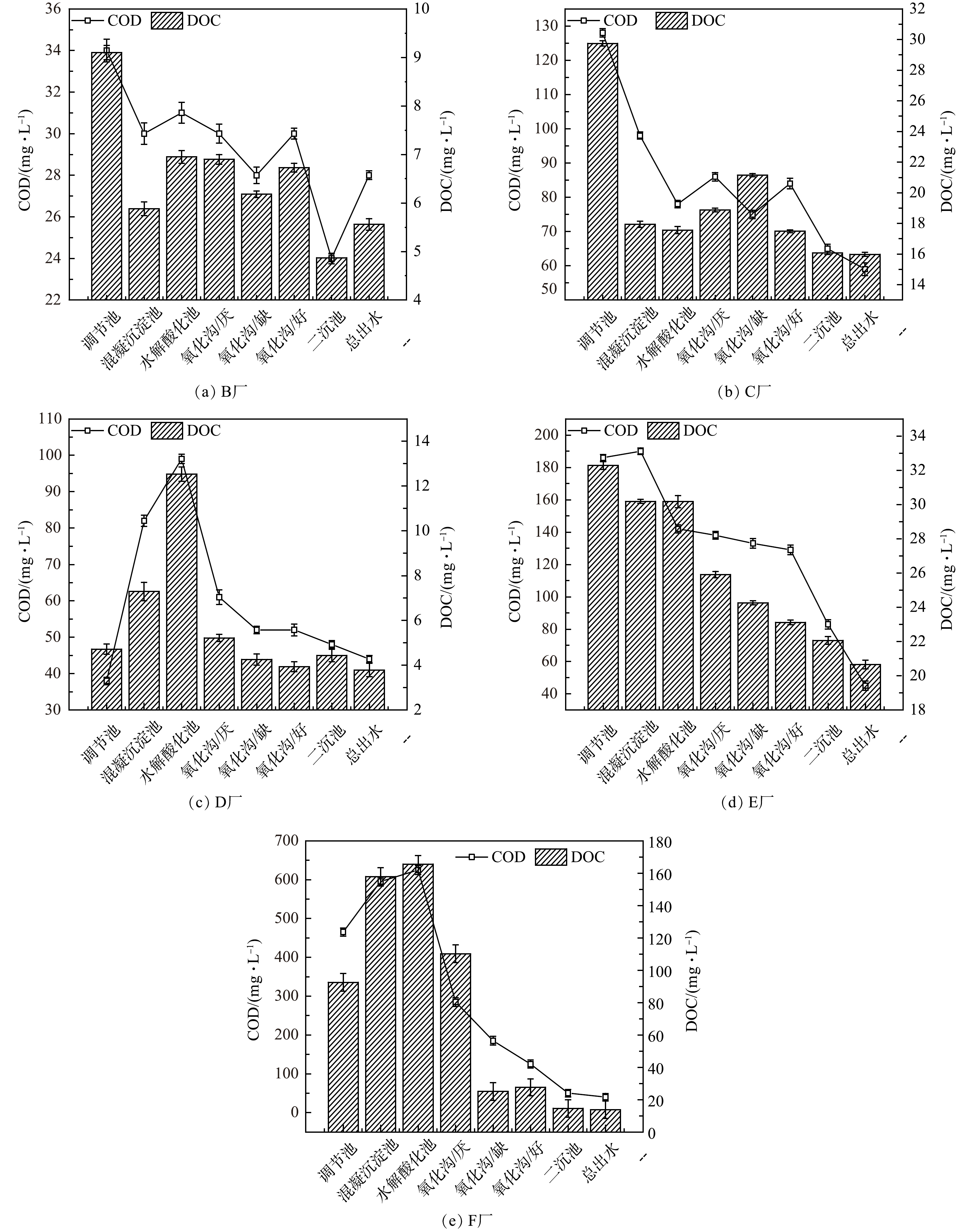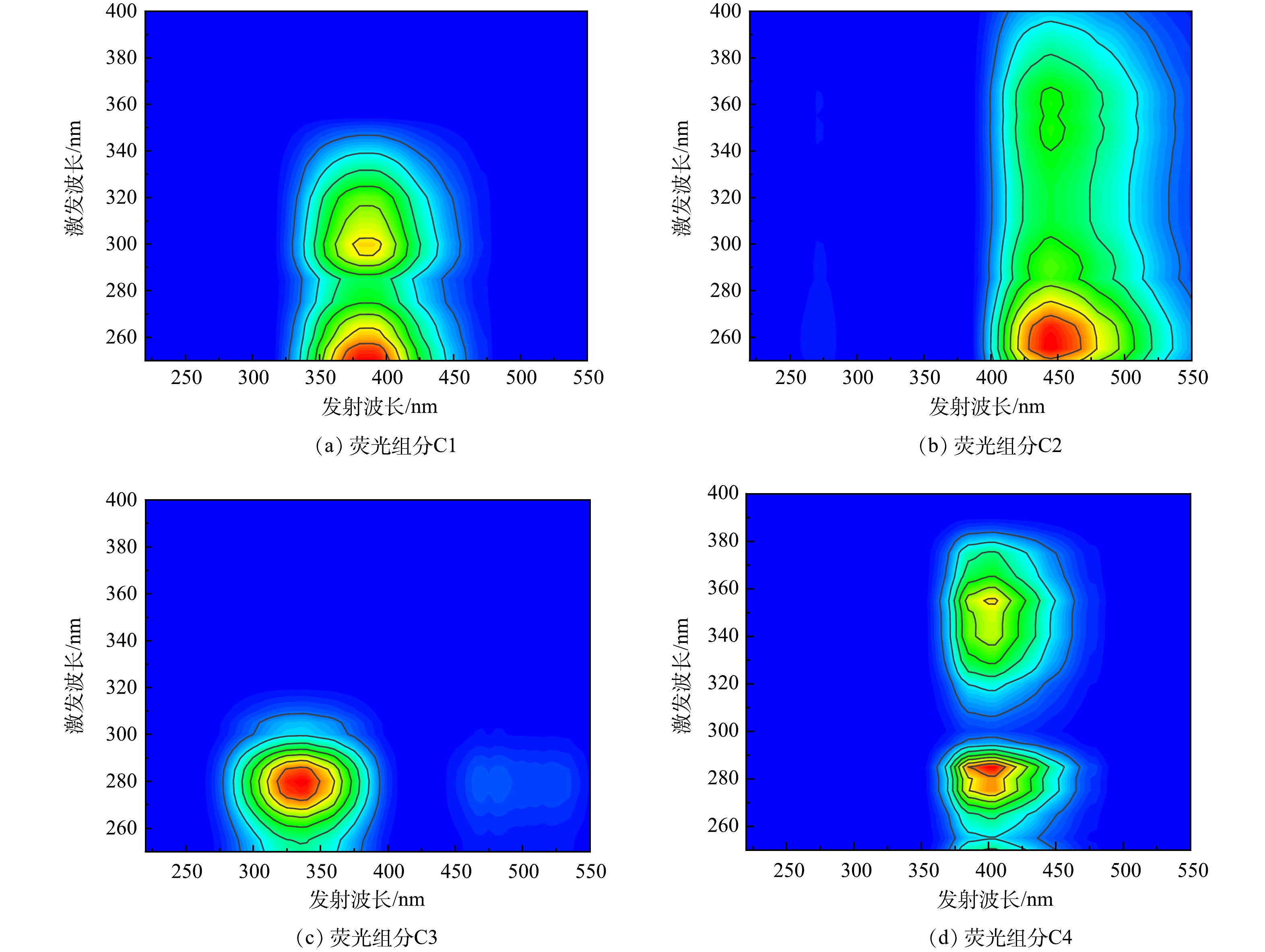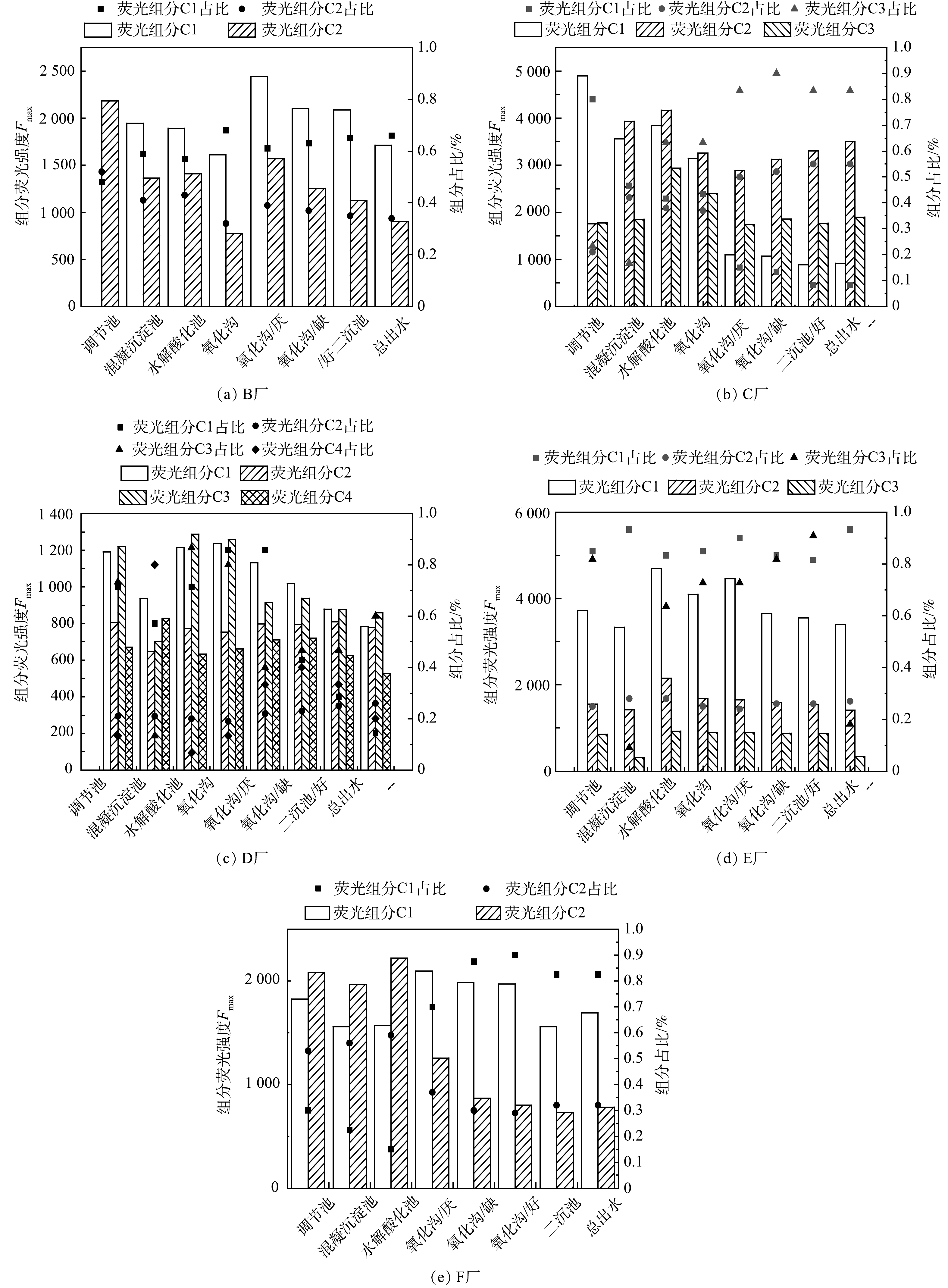-
随着当前我国工业的快速发展,越来越多的企业已经或者将要迁入工业园区,因此工业园区内的污水处理问题日益受到关注。中国政府大力推进工业园区建设,目前全国共有626个国家级园区和1 141个省级园区。工业园区集中式污水处理厂进水多为工业废水,常含有如重金属、对苯二甲酸、邻苯二甲酸、苯甲酸等复杂有害物质,生物可降解性差,毒性大,因此控制和进一步提高工业园区工业废水的处理效率尤为重要[1]。目前工业园区常采用的污水处理工艺与城市污水厂常见工艺相同,包括A2/O(anaerobic anoxic oxic)、序批式反应器(sequencing batch reactor,SBR)和氧化沟工艺等[2]。
近年来,研究者们对城镇污水和工业污水中的溶解性有机物(dissolved organic matter,DOM)的变化规律做了大量研究[3-4],DOM可作为重金属、持久性有机污染物的载体,对这些物质在水体中的迁移、转化起着重要作用。由于有工业废水的引入,工业园区污水中含有的DOM成分相对城市污水厂更为复杂。虽然经过工业园区污水厂处理工艺的处理,但出水中仍会存在不同类型的有机物,可能对自然水体和人类健康存在潜在危害[5-9]。因此有必要了解工业园区污水在处理过程中DOM的组分特征与变化规律。
三维荧光光谱(excitation-emission-matrix spectra,3D-EEMs)分析法是近二十年来发展起来的一门新的荧光分析技术,可获得激发波长与发射波长同时变化的荧光强度光谱图,获得的荧光数据比普通荧光光谱多得多,具有高选择性,可利用多组分混合物的定性、定量分析[10]。近几年来,将三维荧光光谱与平行因子分析(parallel factor, PARAFAC)相结合的方法得到广泛应用,把重叠的EEM 光谱峰值反褶积到相应的独立分量中,使每个分量成为具有相似荧光团的一类 DOM,从而实现对荧光组分的成分分解,通过对完成分解的不同荧光组分进行定性、定量分析来揭示DOM的组分及其来源[11]。目前,对工业园区污水中DOM组分种类与来源及其在处理过程中的沿程变化的研究不多,因此,本研究采用3D-EEMs和PARAFAC方法,重点考察江西省5家工业园区污水厂的污水在以混凝沉淀-水解酸化-氧化沟为主体工艺的处理过程中,DOM的组分变化、削减效果、组分来源特征进行探究,以期为进一步了解工业园区污水处理过程中的DOM特征提供参考。
-
研究对江西省5座工业园区污水处理厂各工艺段污水进行样品采集。5座污水处理厂均采用调节池-混凝沉淀-水解酸化-氧化沟-二沉池-消毒-总出水为主体工艺,设计处理水量10 000~20 000 m3·d−1,实际处理水量为6 500~15 000m3·d−1。调研的各污水处理厂日常会根据进水水质在氧化沟内投加葡萄糖作为反硝化补充碳源。于2021年7—10月,分别对5家污水厂进行3次采样,取样点为调节池出水、混凝沉淀池出水、水解酸化池出水、氧化沟厌氧段、氧化沟缺氧段、氧化沟好氧段、二沉池出水、总出水。将水样装入聚乙烯塑料瓶中,在4 ℃避光保存、运输到实验室进行水质分析。
-
将所采集的样品经0.45 μm滤膜过滤。溶解有机碳(dissolved organic carbon,DOC)由 TOC-VCPH 分析仪 (Shimadzu, Japan) 测定;COD通过哈希预制管消解及DR分光光度计 (HACH, USA) 测定;UV254采用日本岛津UV1240型紫外可见分光光度计测定;采用三维荧光光谱仪(3D-EEMs,HITACHI, Japan)对水样中溶解性有机物DOM进行分析。用HITACHI-F荧光光谱仪连续扫描,测量激发波长(200~400 nm/nm)的荧光强度,生成三维激发发射荧光矩阵。激发和发射狭缝宽度设置为5 nm。
-
采用Origin2018软件对实验结果进行作图。采用MATLAB 2020a软件中dreem工具箱进行三维荧光光谱矩阵的 PARAFAC 分析,采用校正散射(瑞利散射及拉曼散射)检验去除异常值[5]。通过二分法中组分的相似程度和最优平方和误差来判断最佳组分数。使用在线Openfluor数据库对组分进行比对确定。PARAFAC组分的载荷得分,即为当前组分的最大荧光强度(maximum fluorescence, Fmax)[12]。FI(荧光指数)、HIX(腐殖化指数)、BIX(自生源指数)、r(A/C)、 r(T/C)、Fn(255)和Fn(280)等指数根据文献中的方法[13]进行计算。
-
各工业园区污水厂处理过程中COD和DOC的沿程变化如图1所示。B、D污水厂进水中DOC(4~9 mg·L−1)和COD(33~45 mg·L−1)值较低,C、E污水厂进水DOC(28~34 mg·L−1)和COD(120~200 mg·L−1) 值处于中等水平,F污水厂进水DOC(80~100 mg·L−1)和COD(300~500 mg·L−1) 值较高。其中B、D、F污水厂的DOC值在经过混凝沉淀后升高了1~8 mg·L−1,可能是进水携带的部分颗粒有机物在水解酸化池内转化成溶解性有机物所致。虽然各污水厂在氧化沟内时常投加碳源作为反硝化补充碳源,但出水COD为28~60mg·L−1,满足《城镇污水处理厂污染物排放标准 (GB 18918-2002) 》一级B排放要求。
B、C、D、E、F污水厂的进水COD/DOC分别为3.74、4.30、8.05、5.76、5.03。不同来源的污水以及自然水体的COD与DOC之间有特定的相关性[14-15]。由进水COD/DOC值可知,各污水厂的水质有机组分特征差异较大。其中D污水厂的COD/DOC值最高(8.05),表明进水中不含碳的还原类物质浓度相对较高;B污水厂的COD/DOC值最低(3.74)。
SUVA为水样 UV254与DOC的比值,其表示水中有机物的共轭不饱和及芳香程度的指标,SUVA值越大,说明水中有机物不饱和键含量越高,芳香性越强[16]。B、C、D、E、F污水厂的进水SUVA值分别是7.25、8.86、6.23、7.12、5.79 L·(mg·m)−1,C厂进水的有机物芳香性程度最强。B、C、D、E、F污水厂的出水SUVA值分别是1.33、3.32、1.08、2.40、1.68 L·(mg·m)−1,C厂出水中的有机物芳香性程度仍最强,与该厂进水有机物芳香性最强相对应,表明C厂进水中含有较多难降解的芳香性有机物。我国一些典型城市污水处理厂出水的SUVA为0.91~2.35 L·(mg·m)−1 [17],而工业园区污水厂出水SUVA的值为1.08~3.32 L·(mg·m)−1,表明本研究中的工业园区污水厂出水的DOM的芳香化程度,比一般城镇污水厂出水的芳香化程度高。这可能是由于工业园区污水中普遍含有更多的芳香族化合物以及难降解有机物。
-
对工业园区污水厂各工艺段污水中的DOM进行三维荧光光谱分析,可进一步了解各污水中的DOM组分特征[18]。在工业园区污水处理过程中,污水的三维荧光光谱特征沿程变如表1所示。从B厂进水中可以看出,DOM主要组分为类色氨酸和类溶解性微生物产物(soluble microbial products, SMP)。在水解酸化池及其后续单元的水样中,均未检出类色氨酸荧光峰;水解酸化、氧化沟厌氧段和二沉池水样中,均检测出类富里酸荧光峰;在总出水中,仅检测出类腐殖酸荧光峰和类SMP荧光峰,表明经过污水生化工艺处理后,类富里酸荧光峰逐渐聚合成相对分子质量更大、结构更复杂更稳定的类腐殖酸物质。C厂所有水样中仅检测出类SMP荧光峰,而在其他污水厂所有水样中,除SMP荧光峰之外,均存在类色氨酸荧光峰。D厂进水中检出类色氨酸和类SMP荧光峰;混凝沉淀和水解酸化阶段,类富里酸荧光峰消失,但在氧化沟及其后续阶段水样中,类富里酸荧光峰持续出现,未检出类腐殖酸荧光峰。E厂所有样品的DOM组分相似,均只检测出类色氨酸荧光峰和类SMP荧光峰;二沉池和总出水中类色氨酸和类SMP荧光峰出峰位置与进水相同,表明该厂污水处理过程中,这两类DOM非常稳定、难以去除。
在5家污水厂中,仅在F厂进水中检测出介于类酪氨酸和类色氨酸之间的荧光峰,表明在该污水厂进水中存在其他污水厂没有的特殊有机污染物。F厂进水中还检出类SMP和类腐殖酸荧光峰,表明污水厂进水之前,已有过活跃的微生物活动,即部分污水来源可能经过生物处理后排放到综合管网进入工业园区污水厂。在污水处理过程中,酪氨酸类荧光峰持续存在,直到二沉池出水和总出水中未被检出,表明该类DOM可以通过生物处理过程被降解去除。而进水中的类腐殖酸荧光峰在氧化沟阶段及以后的工艺段中消失,表明该类DOM在氧化沟内或被部分降解、或被污泥吸附,因此荧光峰逐渐消失。在二沉池出水和总出水中,仅测出类色氨酸和类SMP荧光峰,这两类荧光峰特征与B厂(类SMP)、C厂、D厂(类SMP)、E厂(类SMP)的出水荧光峰特征相似,表明这类DOM为工业园区污水厂中,趋向于持续存在的DOM。
综合来看,F污水厂与其他污水厂进水差异较大。各工业园区污水厂进水中均检出类SMP荧光峰,类色氨酸和类SMP荧光峰为污水厂中趋向于持续存在的DOM。
-
虽然三维荧光光谱中包含了很多信息,但由于荧光团之间的相互叠加,传统的峰识别方法只能识别谱图中的几个峰值点,这将造成大量数据的浪费。而平行因子法能够对 DOM 的三维荧光谱图进行解谱,充分利用荧光数据,鉴别单一荧光组分[18]。故研究采用三维荧光光谱进行平行因子分析(PARAFAC),对5家工业园区污水厂水样的荧光光谱特征进行进一步解析。工业园区污水厂处理过程中DOM组分荧光光谱图如图2所示。
经过PARAFAC分析,B厂(图2)得到1种类蛋白荧光组分和1种类腐殖酸荧光组分:C1(Ex/Em=245 nm/340 nm)为色氨酸荧光峰,C2(Ex/Em=260 nm/410 nm)为富里酸荧光峰; C厂(图3)得到2种类蛋白荧光组分和1种类腐殖质荧光组分:分别为C1(Ex/Em=240 nm/340 nm)色氨酸荧光峰、C2(Ex/Em=275 nm/320 nm)为SMP荧光峰、C3(Ex/Em=235 nm/400 nm)为富里酸荧光峰。D厂(图4)得到1种类蛋白荧光组分和3种类腐殖质荧光组分:C1(Ex/Em=250 nm/385 nm)与C2(Ex/Em=255 nm/455 nm)均为富里酸荧光峰、C3(Ex/Em=280/335 nm)为类SMP荧光峰类蛋白组分、C4(Ex/Em=285 nm/405 nm)为腐殖酸荧光峰。E厂(图5)得到2种类蛋白荧光组分和1种类腐殖质荧光组分:C1(Ex/Em=235 nm/340 nm)为色氨酸荧光峰、C2(Ex/Em=270 nm/325 nm)为类SMP荧光峰、C3(Ex/Em=250 nm/445 nm)为富里酸荧光峰。F厂(图6)得到1种类蛋白荧光组分和1种类腐殖质荧光组分:C1(Ex/Em=280 nm/330 nm)为类SMP荧光峰;C2(Ex/Em=310 nm/420 nm)为腐殖酸荧光峰。
综上所述,各工业园区污水厂均含有类蛋白质组分和类腐殖质组分。已有研究[16]采用PARAFAC算法解析出工业园区污水的DOM特征,也检测出类蛋白质组分和类腐殖质组分,但出峰位置略有差异。
进一步通过FI(荧光指数)、BIX(生物指数)等荧光参数对DOM来源进行解析。荧光指数FI的值可以表征DOM的芳香性,该值越小表明含有的苯环结构越多,芳香性越强,并且其值还能表征 DOM的来源[19]。FI<1.4表示DOM中的腐殖质主要来源于植物、土壤有机质的分解与浸出的陆源为主,并具有较高的芳香度,FI>1.9表示腐殖质主要由水体中的微生物和藻类活动引起的内生源为主[20]。生物指数BIX指标可以反映土著微生物的生物活性和DOM的新鲜度,BIX>1表示为新近生物或细菌引起的自生源为主。腐殖化指数 HIX 是被用于表征有机质腐殖化程度的指标。OHNO等[21]研究表明,当腐殖化指数HIX 值为0~1时,HIX值的越大,腐殖化程度越深。r(A/C)为紫外光区类腐殖物质荧光峰与可见光区类腐殖物质的荧光峰之比,可用来衡量 DOM 中腐殖质组分的腐殖化程度,r(A/C)的值越高,水中DOM中稳定腐殖组分比重越低[10];r(T/C)值是可见光区类蛋白荧光与类腐殖质荧光的比值,用来评价水质受人类活动污染的程度,也可表示水样中类蛋白物质与类腐殖质比重;Fn(280)代表类蛋白物质相对浓度水平,Fn(355)代表类腐殖质相对浓度水平;Fn(280)和Fn(355)2个指标分别用来表征自生源和陆源对水体DOM的组分的贡献[10]。
在各工业园区污水厂中,各污水厂均有类蛋白质和类腐殖质荧光组分。各工业园区污水厂的进水荧光指数FI均>1.9(表2),说明工业园区污水厂 DOM 中腐殖质来源主要为微生物活动的内生源;C、D、E厂的生物指数BIX>1,表示这3个污水厂中的DOM以新近生物或细菌产生的新鲜DOM为主。各工业园区污水厂中的进水HIX值均在0.8以下,表明各厂进水中DOM的腐殖化程度较低[22]。其中C厂腐殖化指数最小,说明C厂进水中易降解物质占比相对比其他污水厂多[22]。各工业园区污水厂的r(A/C)值大小顺序为E>C>D>B>F,说明E污水厂稳定的腐殖质组分比重最低,F污水厂稳定的腐殖质组分比重最高;各工业园区污水厂的r(T/C)值的顺序为E>C>B>D>F,表明E厂类蛋白质组分比重最高,F厂蛋白质组分比重最低;5家污水厂的Fn(280)均大于Fn(355),表明工业园区各污水厂的类蛋白组分均大于类腐殖质组分,呈现出较强的自生源特征[23]。
-
进一步通过对PARAFAC之后的得到的荧光组分的载荷得分(Fmax)[12]进行分析,可以明确污水处理过程中,氧化沟工艺对水中DOM的去除情况。各个污水处理厂污水处理过程中荧光组分的载荷得分情况如图7所示。由图7可以看出,B、C、D、F污水厂水样的荧光组分的荧光强度波动较大。其中B厂的C1组分、C2组分经过氧化沟工艺后荧光强度明显下降,分别下降了14.1%和59.2%。而C厂水样的C1组分的荧光强度经过氧化沟工艺后,荧光强度降低了81.2%;而其他2种组分的荧光强度降低不明显。D厂水样的C1、C3组分经过混凝沉淀、水解酸化后荧光强度没有明显变化(降低了1.9%~2.3%),但是经过氧化沟工艺后,对C1和C3 2种组分荧光强度分别降低10.1%、31.8%。E厂水样的C1、C3组分经过氧化沟工艺后,荧光强度有明显降低,对C1和C3两种组分的去除率分别达到28.2%、65.3%。F厂水样的荧光组分的荧光强度在经过氧化沟后分别降低了26.2%、63.6%。在B、C、E、F厂中,蛋白类物质荧光组分占比最多,在66%~93%,腐殖质荧光组分占比最少,在7%~34%。处理过程中,C厂C2组分和F厂C1组分增加,分别增加了34%和21%,且2种组分均属于类SMP荧光峰,可能是在微生物新陈代谢过程中产生了较难降解的有机物,且此有机物属于类SMP[8]。
各污水厂水样在经过混凝沉淀、水解酸化后荧光强度和所占比例没有显著变化,可知混凝沉淀和水解酸化对于水中有机物没有明显去除,主要去除污水中悬浮物和沙砾等物质。而氧化沟工艺对水样中的类色氨酸物质和类富里酸物质具有显著削减效果(削减了21%~43%),对类SMP物质去除效果较弱(0~3%),甚至C、F厂的类SMP物质增加。综合来看, C厂的色氨酸类蛋白物质能够很好地被氧化沟工艺去除(降低了43%); D、E、F污水厂的类腐殖质在经过氧化沟工艺后削减明显(降低了31%~80%)。
-
1)调研的工业园区污水厂进水COD/DOC值为3.74~8.05,工业园区污水厂进水比一般城市污水厂的进水有机物芳香化程度要高。
2)工业园区污水厂处理过程中全部水样的荧光物质中类蛋白质>类腐殖质;调研的5家工业园区污水厂的水样主要受到生物源的影响,DOM的腐殖化程度较低;在B、C、E、F厂中,类蛋白质组分占比最高,为66%~93%,类腐殖质组分占比最低,为7%~34%。
3)由于进水中工业废水种类不同,各工业园区污水厂的DOM的组分特征有所不同。工业园区污水厂对类色氨酸蛋白和类腐殖质有机物的削减效果相对较好(21%~43%),对类SMP有机物的削减效果较弱(0~3%);类色氨酸(Ex/Em=235 nm/335 nm;Ex/Em=235 nm/340 nm)和类SMP荧光峰(Ex/Em=285 nm/315 nm;Ex/Em=290 nm/320 nm)为出水中持续存在的DOM。
工业园区污水厂处理过程中溶解性有机物的三维荧光特征分析
Characteristics of dissolved organic matter by three-dimensional fluorescence analysis during wastewater treatment process in industrial parks
-
摘要: 随着工业园区的不断发展,工业园区污水处理越来越引起人们关注。污水中溶解性有机物(dissolved organic matter, DOM)的组分特征对污水处理效果有显著影响。因此,通过三维荧光光谱(excitation-emission-matrix spectra, 3D-EEMs)结合平行因子(parallel factor, PARAFAC)分析,考察了江西5家工业园区污水厂的DOM组分沿程变化特征及其来源特征。结果表明:工业园区污水厂进水COD/DOC在3.74~8.05,进水中有机物芳香化程度比一般城市污水厂的进水高;各工业园区污水厂处理过程中全部水样的荧光物质均呈现类蛋白质>类腐殖质、腐殖化程度较低的特征,DOM来源主要受到生物源的影响;污水厂对类色氨酸芳香蛋白和类腐殖质有机物的削减效果相对较好(21%~43%),对类SMP有机物的削减效果较弱(0%~3%);类色氨酸芳香蛋白(Ex/Em=235 nm/335 nm;Ex/Em=235 nm/340 nm)和类SMP物质(Ex/Em=285 nm/315 nm;Ex/Em=290 nm/320 nm)为江西五家工业园区污水厂出水中持续存在的DOM。本研究结果可为进一步了解工业园区污水厂的DOM沿程变化特征提供科学参考。Abstract: With the development of industrial parks, wastewater treatment in industrial parks has caused more and more attentions. The composition of dissolved organic matter (dissolved organic matter, DOM) in wastewater has a significant effect on the treatment efficiency. Therefore, in this study, DOM components variation along the process and their sources in wastewater treatment plants(WWTPs) in five industrial parks of Jiangxi province were investigated by three-dimensional fluorescence spectroscopy (excitation-emission-matrix spectra, 3D-EEMs) combined with PARAFAC (parallel factor) analysis. The results show that the COD/DOC of the influent in WWTPs in five industrial parks ranged from 3.74 to 8.05, and the aromatization degree of the organic compounds in the influent was higher than that of the municipal wastewater treatment plant. There was more protein-like substance than humic substance-like substance and lower humification degree in the fluorescence organics along the process of WWTPs in all industrial parks. The DOM resource was mainly affected by biological resource. For WWTPs, the reduction of tryptophan-like protein and humic-like organic matter was significant (21%~43%), but the decrease of SMP-like organic matter was weak (0%~3%). The persistent DOMs in the effluent of WWTPs were tryptophan-like protein (Ex/Em = 235 nm/335 nm; Ex/Em = 235 nm/340 nm) and SMP-like fluorescence (Ex/Em = 285 nm/315 nm; Ex/Em = 290 nm/320 nm). This research can provide a scientific reference for further understanding the variation characteristics of DOM along WWTPs in industrial parks.
-

-
表 1 工业园区污水厂三维荧光光谱特征的沿程变化
Table 1. Variation of three-dimensional fluorescence spectrum characteristics along the treatment units of wastewater treatment plants in industrial park
水厂 取样点 峰1(类酪氨酸)
Ex/Em(nm/nm)峰2(类色氨酸)
Ex/Em(nm/nm)峰3(类SMP)
Ex/Em(nm/nm)峰4(类富里酸)Ex/Em(nm/nm) 峰5(类腐殖酸)Ex/Em(nm/nm) B厂 调节池 — 230/335 270/335 — — 混凝沉淀池 — 245/350 — — — 水解酸化池 — — 285/315 245/400 260/410 氧化沟/厌 — — 275/360 — — 氧化沟/缺 — — — 235/420 — 氧化沟/好 — — — 234/410 — 二沉池 — — 285/315 250/415 — 总出水 — — 285/315 — 305/410 C厂 调节池 — — 290~300/320~330 — — 混凝沉淀池 — — 285~300/315~330 — — 水解酸化池 — — 285~295/315~325 — — 氧化沟/厌 — — 285~295/315~325 — — 氧化沟/缺 — — 285~295/315~325 — — 氧化沟/好 — — 285~295/315~325 — — 二沉池 — — 285~295/315~325 — — 总出水 — — 285~295/315~325 — — D厂 调节池 — 230~235/335~340 280~300/310~330 240~250/380~390 — 混凝沉淀池 — 230~245/340~370 280/335 — — 水解酸化池 — 245/370 — — — 氧化沟/厌 — 235/350 285/315 245~250/395~400 — 氧化沟/缺 — 230/340 285/315 240~255/375~410 — 氧化沟/好 — 230/340 280/350 230~245/360~390 — 二沉池 — 230/340 — 240~245/365~385 — 总出水 — 235/350 290/320 240~255/385~410 — E厂 调节池 — 235/345 285~295/315~325 — — 混凝沉淀池 — 230/345 285~300/315~330 — — 水解酸化池 — 285/315 — — — 氧化沟/厌 — 235/345 285~300/315~330 — — 氧化沟/缺 — 235/345 285~300/315~330 — — 氧化沟/好 — 235/340 285~300/315~330 — — 二沉池 — 235/345 285~300/315~330 — — 总出水 — 235/340 285~300/315~330 — — F厂 调节池 230/330 — 280/310 — 305/415 混凝沉淀池 235/330 230/340 280/310 — 310/415 水解酸化池 235/335 235/335 280/310 — 305/420 氧化沟/厌 220/295 210/340 — — — 氧化沟/缺 205/315 230/340 285/315 — — 氧化沟/好 205~230/310~335 — 280/325 — — 二沉池 — 235/335 285/315 — — 总出水 — 235/340 285/315 — — 注:表中数值的单位均为nm。 表 2 各工业园区污水厂DOM荧光参数
Table 2. Fluorescence parameters of DOM in wastewater treatment plants in each industrial park
水厂 荧光指数FI 生物指数BIX 腐殖化指数HIX r(T/C) r(A/C) Fn(280) Fn(355) B 2.45 0.94 0.52 1.56 1.12 1 627.59 743.29 C 2.49 1.08 0.51 1.99 2.07 1 741.90 201.88 D 2.63 1.25 0.63 1.54 1.56 1 236.20 666.68 E 2.17 1.27 0.49 4.45 2.54 1 458.34 198.14 F 3.03 0.49 0.50 0.94 0.50 1 583.86 595.61 -
[1] SHA L, LING Z, TONG T S, et al. Pollution control and cost analysis of wastewater treatment at industrial parks in Tai hu and Hai he water basins, China[J]. Journal of Cleaner Production, 2018, 172: 2435-2442. doi: 10.1016/j.jclepro.2017.11.167 [2] YUE Y, BING W, LIN M J, et al. Comparative analysis of toxicity reduction of sewage treatment wastewater in 12 industrial parks based on battery toxicity assay[J]. Science Report, 2019, 9(1): 1-10. doi: 10.1038/s41598-018-37186-2 [3] 朱松梅, 周振, 谢跃, 等. 工业园区污水厂溶解性有机物转化规律研究[J]. 环境科学与技术, 2016, 39(7): 18-22. [4] SHI Y F, SHEN N L, LI Y W, et al. Characteristics of dom in sewage treatment of 14 AAO processes[J]. Environmental Science, 2020, 742: 140654. [5] 余旭芳, 鲁庆奥, 范行军, 等. 城镇污水处理过程中溶解性有机物的含量与光学性质的变化特征[J]. 安徽科技学院学报, 2021, 35(4): 82-88. [6] 薛爽, 金乌吉斯古楞, 陈忠林, 等. 冬季不同污水处理工艺对溶解性有机物的去除[J]. 中国环境科学, 2015, 35(2): 410-419. [7] 金乌吉斯古楞, 薛爽, 王智, 等. 城市污水处理过程中溶解性有机物及荧光物质的变化规律[J]. 环境科学学报, 2014, 34(9): 2298-2305. [8] 张华, 田纪宇, 黄健, 等. 三维荧光光谱技术对污水处理中溶解性有机物转化过程的分析[J]. 环境污染与防治, 2017, 39(4): 375-378. [9] 赵宇菲. 我国南方某工业园区废水水质指纹特征及解析[D]. 北京: 清华大学, 2016. [10] CORY R M, MILLER M P, MCKNIGHT D M, et al. Effect of instrument-specific response on the analysis of fulvic acid fluorescence spectra[J]. Limnology and Oceanography:Methods, 2010, 8(2): 67-68. doi: 10.4319/lom.2010.8.67 [11] 张广彩, 于会彬, 徐泽华, 等. 基于三维荧光光谱结合平行因子法的蘑菇湖上覆水溶解性有机质特征分析[J]. 生态与农村环境学报, 2019, 35(7): 933-939. [12] 孙伟, 胡泓, 赵茜, 等. 达里诺尔湖水体DOM荧光特征及其来源解析[J]. 环境科学研究, 2020, 33(9): 2084-2093. [13] 宋铁红, 赵凯, 佟娟, 等. 某实际染整废水深度处理过程中无机组分与溶解性有机物的变化[J/OL][J]. 环境化学, 2022: 1-11. [14] 冬玲, 唐清霞. 水环境在线监测总有机碳(TOC)与化学需氧量(COD)之间相关性探讨//中国环境科学学会[J]. 2013中国环境科学学会学术年会论文集(第四卷). 昆明, 2013: 600-604. [15] 刘金凤, 董德明, 姜百川, 等. 自然水体生物膜上有机质COD与TOC之间的比例关系[J]. 科学技术与工程, 2003(5): 479-481. [16] 金鑫, 金鹏康, 孔茜, 等. 基于PARAFAC分析的二级出水DOM臭氧化特性研究[J]. 中国环境科学, 2015, 35(2): 427-433. [17] 程澄, 钱玉亭, 黄振荣, 等. 江苏江阴污水处理厂排水的三维荧光光谱特征[J]. 光谱学与光谱分析, 2021, 41(12): 3791-3796. [18] 汪玲玲. 三维荧光光谱技术在溶解性有机物研究中的应用[J]. 环境科学与管理, 2015, 40(1): 153-155. [19] 王丽莎, 胡洪营, 藤江幸一. 污水氯和二氧化氯消毒过程中溶解性有机物变化的三维荧光光谱解析[J]. 环境科学, 2007(7): 1524-1528. [20] 何小松, 席北斗, 张鹏, 等. 地下水中溶解性有机物的季节变化特征及成因[J]. 中国环境科学, 2015, 35(3): 862-870. [21] OHNO T. Fluorescence inner-filtering correction for determining the humification index of dissolved organic matter[J]. Environmental Science & Technology, 2002, 36(4): 742-746. [22] ZHANG Y, LIU M, QIN B, et al. Photochemical degradation of chromophoric-dissolved organic matter exposed to simulated UV-B and natural solar radiation[J]. Hydrobiologia, 2009, 627(1): 159-168. doi: 10.1007/s10750-009-9722-z [23] 尚丽平, 杨仁杰. 现场荧光光谱技术及其应用[M]. 北京: 科学出版社, 2009. -




 下载:
下载:







